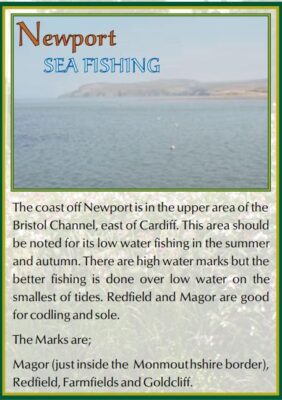SEA FISHING ANGLESEY

Information;
The 125 mile coastline offers beaches, piers, jetties and rocks which are ideal for shore fishing, and there are also many established points right across the Island. The variety of catch is wide and varies throughout the seasons.
Rock marks around Trearddur, Penmon (Puffin island), Menai strait. Point Lynas, Amlwch.Llanbadrig, Around Anglesey’s coast line it is possible to find a fishing venue to suit all tastes. Storm beaches, sheltered beaches, harbours, jetty’s, rockmarks and cliff tops. Whatever your preference there will be a mark to suit you
Local anglers may think dogfish are pests but caught on light gear they can be fun. Wrasse and small pollock caught on a light bass rod provide good sport. Mackerel can be found on the southern coast from as early as april, following the sandeel shoals around the island until they can be caught almost anywhere. Dusk and dawn being the best times. If you are fishing for fun or on holiday with no freezing facilities, please do not kill all the fish you catch. Mackerel do not keep well and if not kept cold, they are no good for bait or human food after a few hours in the sun.
Bait can be collected at a few places, crab in the Menai strait, Lug in Red Warfe bay and Ragworm around Holy Island. If like me you want to fish not collect bait on the few occasions fishing trips are possible then a bait supplier is needed. There are shops around the coast that sell bait, but it is best to ring beforehand to place an order to ensure a fresh supply.
Charter Boats: There are more charter boats in this area than any other county of Wales. With an array of fishing marks and points to fish, then Anglesey is the place to visit.
CHARTER BOAT & TACKLE Hire
Merlin Sea AnglingHortons

Address: Nose Lane, Rhyl
Post Code LL18 5AS
Phone: 07863 774909
Website: https://merlincharters.co.uk
Additional information; Skipper has over 20 years of boating experience & holds an MCA Masters Certificate. The vessel is available for both offshore wrecking, generally mixed fishing & inshore trips throughout the year.
Go Angling Charter Services
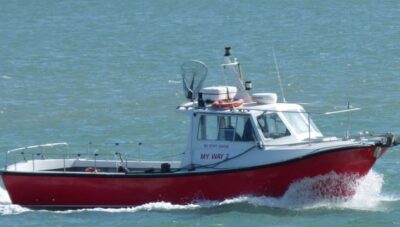
Address: Holyhead Marina,
Phone: 01248 716315
Website: https://goangling.co.uk/
Additional information: The My Way 2 is a fast and spacious Offshore 105, capable of fishing 10 anglers with ease, she has a top speed of over 24 knots.
Kerry Kim Fishing Trips
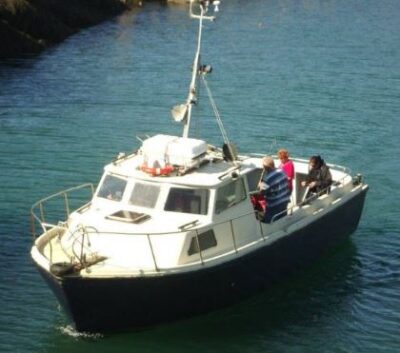
Address: Amlwch Port
Phone: 01407 831526 / 07818 262832
Website: https://www.facebook.com/groups/202278129935109
Additional Information: Day trips, evening trips. From expert to novices fisherman. Tackle, rods and bait supplied
Spindrift New Dawn
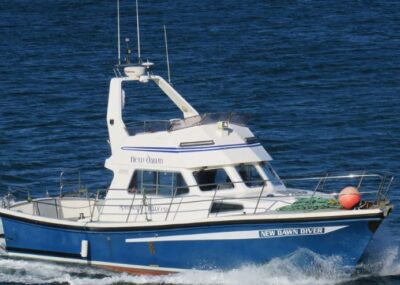
Address: 2, Holyhead, Fish Quay
Tel: 01407 765160 / 07967 911087
Website: https://www.facebook.com/spindriftfishing/
Additional information: charter boat fishing site seeing bird watching commercial work boat trips Holyhead fishing film work
Lander Charter Fishing Trips
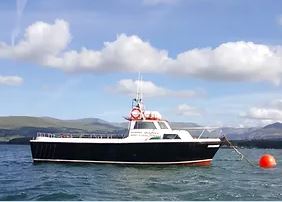
Address: Beaumaris Pier, Pier House, Alma St, Beaumaris
Post Code: LL58 8BS
Phone: 07850 986309
Website:https://www.landercharter.co.uk/
Additional information: Choice of 3 boats, Maverick, Morio-Mon and Lancer 11 Sail from either Bangor, Beaumaris, Caernarfon or Menai Strait depending upon the tides and weather at the time of departure. Facilitates for wheelchairs.
Stingray Angling Charter
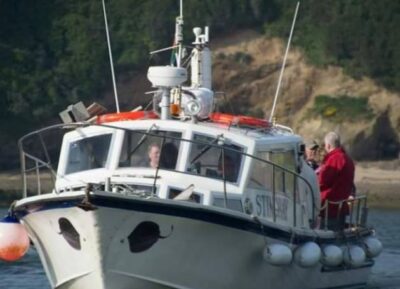
Address: Boat House, Beach Rd, Cemaes Bay
Post Code: LL67 0ES
Phone: 01407 710510 / 07860 175111
Website: http://www.seafishingtrips.co.uk/
Additional Information: Stingray is a safe purpose built vessel, comfortable and well founded, fully insured in full compliance with the 60-mile code of practice.
Starida Puffin
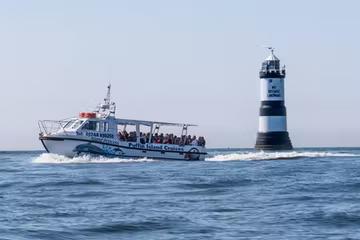
Address: Beaumaris
Post Code: LL58 8BS
Tel: 01248 80379
Website: https://starida.co.uk/
Additional Information: Island Cruises and Sea Fishing Trips Tourist attractions
Sea Cat Charter Boat (Jon Shaw)
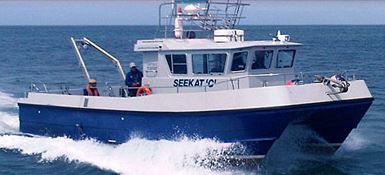
Address: Rhiwlas, PENYSARN,
Post Code: LL68 9NE
Tel; 01407 830040
Website:http://www.seekatcharters.co.uk/
Additional information: SeeKat Marine Charters are able to carry out a wide range of marine related work. See website for more information
Julie Anne Diving Charters
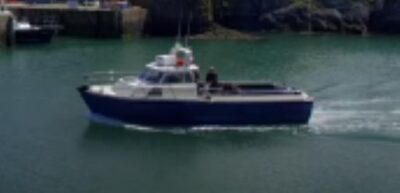
Address: Bryn Eleth, Peniel Square, Amlwch Port
Post Code; LL68 9HG
Phone:01407 831210
Website: https://www.julieanncharters.co.uk/fishing
Additional information: 2 charter boats available Julie Ann Licensed for 12 anglers or divers and the Empress Licensed for 10 anglers or divers Fishing Trips 4/6/8/10/12 hour, Wreck and Reef Fishing, Rods, Reels and refreshments free of charge
Anglesey Charter Fishing Bad Bayz 11
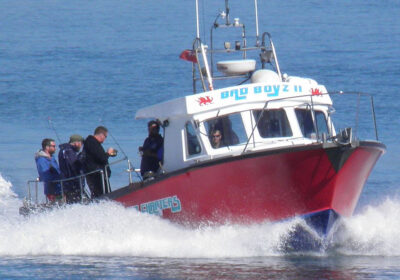
Address: Newry Beach Holyhead
Post Code: LL65 1YA
Tel: 07966 061598
Website: https://angleseycharterfishing.co.uk
Tel; 07711 984952 / 0800 0830 368
Additional information; fishing trips from Anglesey sailing daily out of Holyhead MarinaOne of the top wreck fishing boats n the North of Wales
Roy Smith – Offshore Wreck Fishing
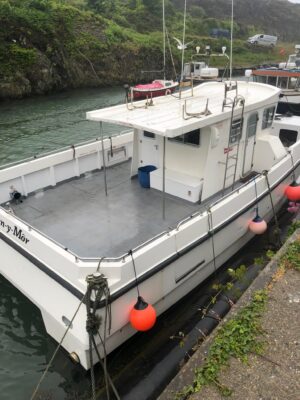
Address: Harbour Buildings, Amlwch Port, Marine Terminal, Amlwch
Post Code: LL68 9DB
Tel: 01407 832010 / 07974 477081
Website: https://tinyurl.com/Roy-Smith-Charter
Additional Information: Wreck and General fishing
Sea Fishing Shops
Telboy Fishing Tackle: 5 Queens Street Amlwch Anglesey LL68 9AE Tel: 01407 832965 Website: www.telboystackle.co.uk/
SEA fishing
Location; NORTH WALES
FLINTSHIRE
The Dee estuary is very important to anglers. When gales and heavy seas stop angling on the open beaches, the good old Dee estuary still offers sheltered fishing. Dee venues also offer fish to close in casters and is the place we all take the kids to introduce them to fishing where they can fish with a small rod close in for flounder and plaice. The Dee is the closest sea angling venue for people traveling from the north. The Dee is also a major run for salmon, sea trout, and bass. Some excellent saltwater fishing can be had in the estuary of the River Dee, especially between Fflint and Talacre. Species to be found there include plaice, flounder, dab, eel, conger, whiting, cod, mullet, sole and bass.
There is vehicular and pedestrian access to the river bank via public highways and public footpaths leading from the A548 coast road at several locations.
Although the Dee Estuary is a nursery area the prohibition on bass fishing in nursery areas does not apply to fishing from the shore. However, it is expected that shore anglers will respect the need for this prohibition and return to the sea any bass caught within nursery areas.
For the purpose of defining the nursery area in the Dee estuary, it is all tidal waters enclosed by a line drawn 213° true from Hilbre Point to Mostyn Quay
The Dee is the closest sea-angling venue for people travelling from the northwest.
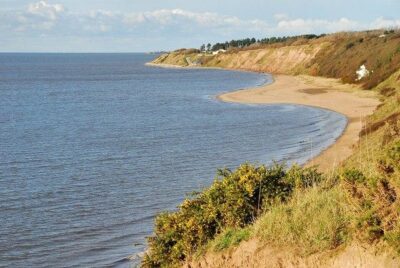
Charter Boats Flintshire
Jensen Sea Angling
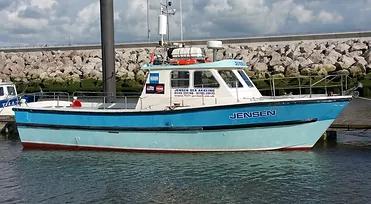
Addtress: Rhyl
Post Code: LL18 5AS
Tel: 01745 332766
Website: https://www.fish-jensen.co.uk/
Additonal information: A family run business operating two boats both fully licensed and insured for up to 10 passengers cat. 2 c.o.p. for up to 60 miles offshore JENSEN 11 & SUVERAN 11
Gwen Paul M, a Sea Cat
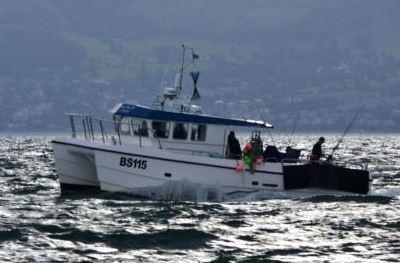
Address: BBryn Awelon, Pentywyn Road, Deganwy
Post Code: LL31 9TL
Tel: (01492) 572707 Mobile: 07710 819747,
Website http://sea-fishing-trips.co.uk
Additonal informaton: 2 Charter Boats. Sea Fishing Trips in Conwy, North Wales, specialises in wreck fishing, deep sea fishing, and reef fishing. The chartered boat, Gwen-Paul-M, with full wheelhouse electronics, will take you fishing anywhere from Anglesey to Liverpool Bay on specialised boat trips to catch fish including pollack, cod, conger, bass, and mackerel
Location; North WEST Denbighshire / PWLHELI
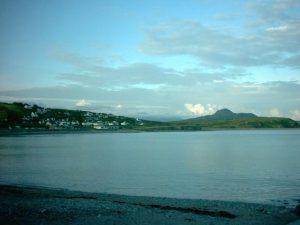
Information; The area draws anglers from across the UK, though many parties are made up from anglers from the Midlands, Shropshire, North Wales and Manchester. It has built up a reputation for consistent catches of a wide variety of species throughout the summer months.
WHERE TO FISH
The area sports a wide variety of ground. To the south lies Sarn Badrig or St Patrick’s reef. This mostly smooth pebble reef runs for 14 miles due west out into Cardigan Bay and is so shallow in places that it dries out 10 miles offshore on the biggest spring tides. Muddy Hollow is a much deeper trench that runs westwards, and as it says has a bed of mud and sand. Closer inshore there are huge expanses of clean sand banks, but also rougher ground patches within half an hours steaming time. There are more productive clean ground marks to the east inside Tremadog Bay.
SPECIES
Taking January first, then Muddy Hollow will be full of plump whiting and dabs, plus thornback ray and huss, all of which make up catches until May when the first tope are taken just west of the Badrig reef.
Mackerel move into the deeper water west of Pwllheli during late April and quickly increase in numbers, as do the black bream which inhabit all the reef and rough ground patches. It’s late May before the pollack, mainly small 2lbers, move back onto the rough along with wrasse.
June can see stingray to record proportions close inshore and the old boat record came from Pwllheli, a fish of 61.5lbs. This is the month for the best tope fishing when fish average 25lbs-30lbs and can be taken in numbers upto 30 fish and more per day.
It’s much the same throughout July, August and September with tope, rays, huss, bream and gurnards an everyday catch. Porbeagle shark also roam these waters in this mid summer spell. Solitary monkfish can show from clean sand areas near to the reefs and rough ground. Some good wrasse inhabit the rough ground, but few anglers bother to fish specifically for them.
September sees the whiting hordes move back inshore, along with dabs, and there’s the chance of small codling from the rougher ground to the west. The mackerel are gone by October in normal years. Herring can appear in big shoals during October to Christmas.
TACKLE
The beauty of this area from the anglers point of view is that the tides are slow running, even on the big springs. Rarely will you need more than 8ozs of lead to hold bottom unless you’re fishing way out in Muddy Hollow. For the bream, you fish as little as .5oz and 1oz over the reefs.
A 20lb class rod is good for the rays, huss and tope, though most anglers choose an uptide option for versatility. Bream need nothing more than a light spinning rod some 8 to 10-feet long, small fixed spool reel and 8lb line. It’s the ultimate fun. Light boat rods or spinning rods prove the best bet for whiting, etc.
TIDES With the tides not running too fast they are more critical for specific species. The tope, and rays prefer some run to feed so the bigger tides are the best option, though they still feed during the neaps. Tides can run fast on the shallower reef sections, so neaps can be better for the bream in places. Huss don’t care and feed anyway.
Summer stingray are bet sought on mid sized tides, with porbeagles more frequent on the springs. Whiting, dabs, and gurnards aren’t choosy, either!
BAITS
Tope, huss, rays and gurnards are all taken on fish strip. The bream eat mackerel strip, squid strip, lugworm and even peeler crab. Pollack take feathers on the reefs, or the small redgills in black and red. Try a cocktail of mackerel and squid for the early rays and a whole small whiting for huss and tope as an alternative.
ALTERNATIVE SHORE VENUES
Non better than Pwllheli beach for thornbacks, bream, dabs and bass in the summer and autumn. Excellent whiting, dabs and dogfish during the autumn and winter. Big flounder take crab fishing low water into the Marina channel entrance. Mackerel on evening tides too.
Sea Fishing Charter Boats North West
Enlli Charters12 Glanydon
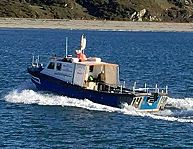
Address: Industrial Estate, Pwllheli
Post Code: LL53 5YT,
Phone: 07836 293146
Website; http://www.enllicharter.co.uk/
Additonal information: Tony & Jayne Bruce have been running boats out of Pwllheli & Porthmadog for many years. The Highlander II sails from Pwllheli
Location; WEST WALES
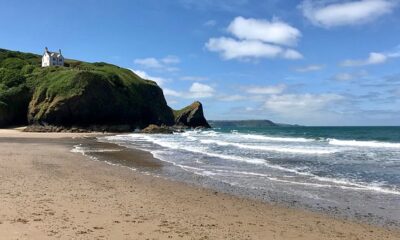
The West coast including Aberystwyth , is home to one of the largest charter fishing fleets in Wales. It’s no coincidence this. “Aber” sports some of the most varied ground imaginable with a species resident list only equaled by the prolific waters off Devon and Cornwall.
NOTED MARKS AND GROUND FEATURE
Chief amongst these is the reef of Sarn Cynfelyn or Patches reef. A reef constructed of small pebbles intermingled with rock and weed beds. This breaks its sequence 3 miles out being mixed sand and rough. Known as the “Gap”, this holds tope, huss, rays, bream, etc. At 7 miles sits the Patches buoy. Ground immediately to the northwest gives cleaner patches of mud and sand, but also uplifting rocky peaks that harbour bream. Ground due north is mainly clean sand until you hit Sarn Bwch reef off Tywyn.
South of Patches Reef lays the Cadwgan Reef just to the north of Llanrystyd. This too holds bream, huss, early and late season tope, plus monkfish which have topped 80lbs in nets here. However, few boats fish this area. Out from the Cadwgan Reef is the old “Trawling grounds”. Literally, a deeper gutter that travels roughly from north to south. This harbors most species and has given hake and smoothhound in the distant past.
WRECK FISHING
The charter fleet is currently checking the potential of numerous wrecks that lay out beyond the 40-mile mark. Trips made in the last couple of seasons have brought home Pollack to 20lbs, ling to 14lbs, and cod to 18lbs. Undoubtedly, big conger and larger pollack, coalfish, ling and cod than already taken are sure to follow.
SPECIES Fishing begins in March with the incoming thornback ray. Numbers taken can exceed 40 per day, but all the local skippers have a catch and return policy, so the bulk are there for another day. The thornbacks stay the main target until early May when the tope take precedence. Catches of this sleek predator often top 20 fish per day with double that not unusual. The average size lays between 30 and 40lbs which is high compared to other areas.
During this early spring period, huss occur daily and can top 16lbs. Whiting, dabs, dogfish, plus the odd monkfish make up the early season catches. May sees the black bream arrive. These run in tight groups over the reefs and rougher ground with fish of 1lb normal, but sprinkled with a regular return of 2lb and 3lb plus fish.
By late June all eyes focus on shark. Porbeagles running towards the 200lbs mark with 100lb fish somewhere about average. July is the main month for shark, but they can linger throughout August too. June also sees the mackerel beginning to shoal up and with them come the interesting mid summer species like pollack, gurnards, turbot, occasional blonde ray, scad and garfish.
Late August sees the catches of whiting increase as the first shoals moving in for the winter are located. A 1lb fish is classed as good here, with 2lb fish very rare. The rays and huss linger throughout the winter, but by early October the tope move out. Codling are not considered a main catch, but the past five seasons has seen fish in fair numbers on the reefs and rough ground bringing in variety to the rays, whiting, dabs and dogfish that make up the normal winter’s day sport.
TIDES AND WEATHER CONDITIONS
Tides off Aberystwyth are not too fierce. It can run at a fair rate over the shallower reef areas, but is sedate over the cleaner ground, even on the biggest spring tides. The size of the tide does not appreciably effect the quality of the fishing. Catches remain pretty consistent throughout the tide cycle.
Over the offshore wrecks however, it does flow strongly and only the smaller neaps are comfortable to fish.
TACKLE
Due to the light tides, you can fish with lighter tackle for all the species save for wrecking and shark. A 20lb class rod or 4-10oz uptider covers just about all options. Local anglers prefer the uptider as it gives greater versatility and more sport. Match these to a reel holding 300yds of 18lb line.
Bream fishing requires a spinning rod about 9ft long, small multiplier or fixed spool reel and just 8lb line. They get the chance to show their true metal on this outfit.
Leads average between 4-8ozs for general fishing, but a couple of 12oz or 1lb weights should be carried for those bigger tides. A 1-2oz lead is plenty for the bream over slack tide periods.
Standard wreck tackle of 50lb class rod and reel are needed for pirk fishing for cod or using pirks and muppets for pollack over the wrecks, and for the shark. The uptider covers fishing artificial eels for pollack with 15 to 18lb line. Experienced anglers choose a 12lb class outfit and 6 to 8oz leads. Many anglers prefer the lighter 30lb tackle for the greater sport.
BAITS
Mackerel is undoubtedly the most popular bait used and enough can mostly be feathered on the day. However, it’s not necessarily the best bait to use.
A whole small whiting or half a dab proves the better bait for tope, rays and huss, especially the whiting. Use peeler crab over the reef and you’ll pick up ballan wrasse, codling, maybe a rogue smoothound.
The bream like small strips of squid, mackerel or herring, but those in the know also carry a few estuary cockles. This latter bait can be devastating at times. Lugworm tends to pick out the smaller bream.
Feathers baited with lugworm picks up codling and bream. Change to mackerel strip on the feathers and you’ll see gurnards, whiting, and weevers over cleaner ground.
ALTERNATIVE SHORE VENUES
Try the Stone Jetty on the south side of the harbour for conger, silver eels, dabs, dogfish and flounders. Also Tan y Bwlch beach for bass, dabs, dogfish, and occasional rays.
Charter Boats West Wales
Broadside Boat Charter
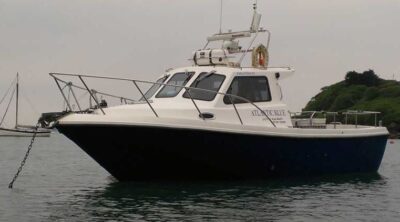
Address: Blue Anchor Way, Dale, Haverfordwest
Post Code:SA62 3RB
Phone: 07768 935681
Website: http://www.broadsidedale.co.uk/
Addionional informaton: Broadside Boat Charter, provider of sea angling and pleasure trips running out of Dale at the heart of the Pembrokeshire Coast National Park
Epic Fishing Trips
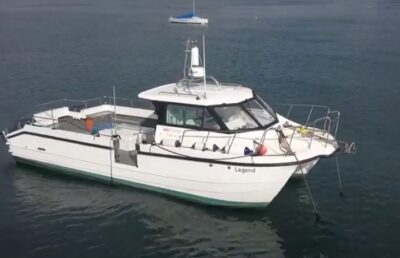
Address: New Quay
Post Code: SA45 9NW
Phone: 07989 496526
Website: https://www.epicfishingtrips.co.uk/
Additional information: fishing trips take place in one of the UK’s richest environments for marine wildlife
Blue Shark Chartes (New Quay Boat Trips)
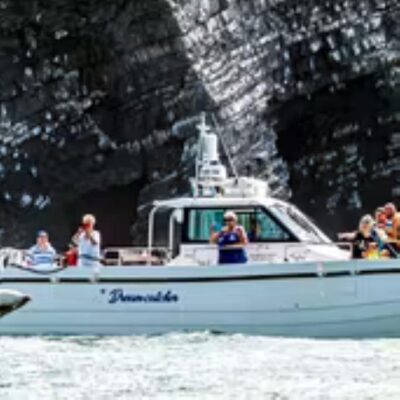
Address: St Davids NewQuay
Post Code: SA45 9NW
Phone:01545 560800
Website: https://newquayboattrips.co.uk/
Additional information: 1 -8 hour fishing trips, including mackerel fishing, wreck fishing, and more.. see website for more information
Awesome Fishing (Bang Tidy)
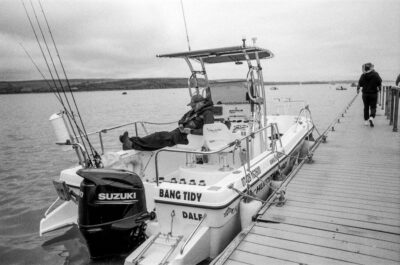
Address: 6 Church Cl, Marloes, Dale, Haverfordwest
post Code: SA62 3RB
Tel: 07428 162600
Website: http://www.fish4bass.tel/
Facebook: https://www.facebook.com/awesomefishinguk/
Additional information: Pro-guided fishing trips specializing in modern light lure fishing
Tenby Sea Fishing
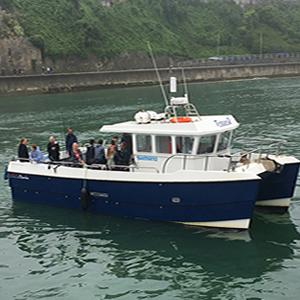
Address: Tenby Harbour, Tenby
Post Code: SA70 8HT
Tel: 07837 405816
website: https://www.tenbyseafishing.co.uk/
Additional information: Specialising in mackerel fishing. The “MV Triton 2” is a purpose built catamaran used for providing daily fishing trips. It is a very stable yet powerful boat (2x200hp engines) capable of 25 knots
Haven Boat Charters
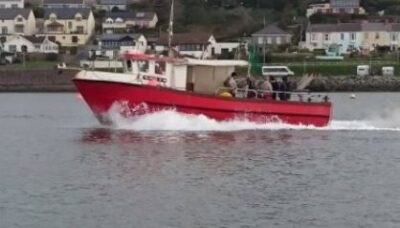
Address: The Pontoon, Pier Road, Pembroke Dock
Post Code: SA72 6TR
Tel: 07774 294959
Website: http://www.havenboatcharters.com/
Additional information: suitable for all, novices and experienced anglers alike. All tackle and equipment can be provided if needed. These trips are usually within the sheltered waters of the Milford Haven Waterway and can provide great catches.
Loation; PEMBROKESHIRE
Pembrokeshire has some of the finest sea fishing in Britain, especially for bass, while the rivers are noted for their salmon, trout and sewin. There is a wide variety of sea fish and various methods of fishing. Regular fishing trips and charters are available at many of the small ports and harbours around the coast. Spinning for mackerel, bass and pollock can be done from the rocks, while the larger beaches are fine for beach-casting. Freshwater West and Newgale are among the top few beaches in Wales. Estuary fishing can provide good sport on light tackle for bass in the summer and flounders in winter. The Teifi estuary in the north and the creeks off the Milford Haven waterway in the south are rated highly. Shore fishing from rocks or beaches is the most popular sea fishing pursuit, with the areas between Druidston and Freshwater West and around St. Davids providing arguably the best shore fishing in Wales. If you are gregarious, some of the more popular beach marks can be busy when local Clubs and Associations hold periodic competitions, but many areas can still be fished in wonderful peace and isolation, and you can often have a whole beach or headland to yourself. Mackerel, garfish, bass, pollack, wrasse, dogfish and tope can be taken from rock marks, whereas the storm beaches can provide excellent fishing for bass and flatfish in the Summer, and flounder, codling and whiting in the Winter. In the latter category, Freshwater West and Newgale beaches are amongst the best in Wales. Winter fishing on the estuaries of the Teifi at Poppit Sands and of the Eastern and Western Cleddau on the Daucleddau and Milford Haven can provide good bags of flounder, cod, and whiting. Mullet are found throughout the year, and the deeper channels of the Milford Haven can even hold conger and ray for those bottom fishing with heavier gear. Fishing boats can be chartered from a number of the harbours around the coast, particularly from Saundersfoot and Tenby on the south coast, Neyland, Milford Haven and Solva in the west and Fishguard in the north of the County. These trips can range from a half hour tour of the harbour area to seek mackerel, to all day offshore reef and wreck fishing for large turbot, ling, conger, bream, ray, and pollock, and even blue and porbeagle shark are numerous within easy range. It is always wise to check that the skipper has all the necessary insurance and licenses to allow him to carry passengers before you agree to go out on a boat-fishing trip, but the rewards of a trip with a knowledgeable and professional skipper can be considerable. With the warm waters of the Gulf Stream come many unusual visitors to add potential interest and a hint of the exotic to a fishing trip. Trigger fish, gilthead bream and sunfish are periodically caught and there is always the chance of a sighting of a turtle, a basking shark or even a pod of killer whales along with the more usual dolphins and porpoises. From the capture of the then world record 74lbs. tope out from Saundersfoot in 1964 to the holding of the European Sea Angling Championships in Tenby and Milford in 1999, the sea fishing potential of the Pembrokeshire coastline is still being realised, and many surprises and specimens are out there to be caught.
Charter Boat Pembrokeshire
Awesome Fishing (Bang Tidy)

Address: 6 Church Cl, Marloes, Dale, Haverfordwest
post Code: SA62 3RB
Tel: 07428 162600
Website: http://www.fish4bass.tel/
Facebook: https://www.facebook.com/awesomefishinguk/
Additional information: Pro-guided fishing trips specialising in modern light lure fishing
Location; SOUTH WALES
SWANSEA
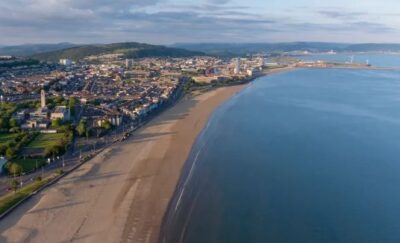
The modern marina sports a popular charter boat fleet and access from inland via road is easy with the M4 motorway close by. Swansea is also home to vast array of smaller private vessels enjoying the quality summer and winter fishing on offer.
WHERE TO FISH
The ground off Swansea is a mix of clean sand and mud, rough ground patches, reefy ground consisting of coral, and further out undulating sand banks.
One of the more popular areas is the Outer Green Grounds which gives some of the bigger post Christmas cod. This lies more towards Mumbles at the outer edge of Swansea Bay itself and is made up of mixed ground amongst sand.
Another noted area is the White Oyster Trench. This is a deep gutter running parallel with the shore on a line set between Langland Bay and Pwlldu Head with a depth up to 100-feet. The tide run here can be bad and few boats bother to work this area in anything over medium sized tides.
Also rated are the distant Scarweather Sands, a good bass and ray mark, plus the Kenfig Patches to the south-east, again sand but holding turbot to 4lbs with occasional 10lb plus fish and quality rays.
The beauty of Swansea is that most of the popular marks are within Swansea Bay itself and only a short steam of maybe 20 minutes is required to reach the prime fishing grounds. Just long enough to tackle up before the skipper sets the anchor.
SPECIES
The cod move inshore during mid to late October officially, but a few earlier fish are intercepted, a vanguard of the main shoals. The prime months are from mid November through to mid January, though the cod stay until April some years.
There’s a chance of a 20lb cod during December, but the bigger 30lb and the occasional 40lb cod, like the one featured here, show from mid January through to late March.
April can be a quiet month, but by May small-eyed, spotted and thornback rays are showing in good numbers. These stay pretty much through to Christmas. The deeper water offshore also holds blonde rays to a good size.
Tope move-in during late May and June with fish to over 50lbs on the cards. The same period sees good bass working the sand banks and staying through to the autumn. From June, you’ll also intercept smoothound until late August and plaice.
Mackerel make a showing in June and by the end of the month encourage a few porbeagle sharks within range. The porgies stay until late July before heading out and north. Catches of shark recently have fallen due to both commercial pressure and some individuals killing sharks for their food value, a practice that is now frowned upon by professional skippers.
The reef structures hold black bream through the summer and give a year-round procession of conger, some of these touching over 40lbs and accompanied by bull huss. Turbot and very occasional monkfish show over the sand and sand banks.
The offshore wrecks can give excellent pollack fishing at times with fish well in to double figures. This is a high summer sport, and the wrecks also produce out of season cod, huss, and big conger. No boats seem to target the wrecks in the late winter period due to the weather, but you have to wonder just how big some of the residents cod go on these.
The swing to winter arrives again with the influx of whiting that appear in numbers from early September. Dabs are an alternative target from October when they move tighter inshore over the clean sand off Swansea itself and off Aberavon Sands and Porthcawl.
TACKLE
Even inside Swansea Bay the tides can run with some force on the bigger spring tides. For this reason, most anglers favour fishing with an uptide rod and casting their baits away from the boat. I’d suggest a 3 to 5oz uptider for the summer fishing when after bass, rays and tope, but opt for the heavier 5oz to 8oz version for the big winter cod. A multiplier reel like the ABU 7000C is ideal when loaded with 18lb line.
Carry leads of 5ozs, 6ozs and 8ozs with breakout wires and fixed grip wires. These will see you through anything the tides can throw at you providing you let out enough line immediately after the cast.
For downtide fishing, choose a 30lb class rod and reel holding about 300-metres of line. You’ll need leads up to a pound. This tackle is suitable for trotting a big whiting or pout live-bait back from the stern of the boat to target conger and big winter cod.
For the bream, a lighter spinning rod handling leads up to 3ozs and either a multiplier or fixed-spool reel and 10lb line is perfectly adequate and gives maximum fun.
The best rig for both uptide and downtide fishing is a long and low rig with the hook trace of about 36-inches (90cms) fixed just above the lead to keep the bait tight to the seabed. Hand the bait on the grip wires of the lead for uptide casting to protect other anglers in the boat.
TIDES
For the offshore wrecks, choose only the very smallest neap tides. The drift is slowed down to acceptable levels on these and the fishing time is maximised.
The medium tides produce summer bass, rays, tope and bream well enough, but for the winter cod you need the medium to very biggest springs. Personally, I choose only the biggest springs as experience has shown that the best numbers of fish are inshore and feeding at this time.
The same applies to the sharks. These move in with the mackerel shoals that come tighter to shore during the bigger spring tides. The shark fishing is done on the drift, though I think that boats who experiment with anchoring during the neap tides could do just as well for the duration of the shark fishing season.
BAITS Anglers here will tell you to fish only black lug baits. This is true of the lug has not been gutted as they still have all their juice when added to the hook and put lots of scent in the water. If you only have gutted black lug, then buy some fresh blow lug and add a couple or three of these to the bottom of a black lug bait. This adds enough juice to already bulky bait to bring the cod homing in.
Worm baits also take whiting, dabs, dogfish and host of other species including the summer plaice. Fish baits are good for the rays and conger, but they also take whole small fish well when down-tiding.
Over the inshore reefs, any bass will take large worm baits or peeler crabs, but over the sand banks the killer bait is live sandeel or whole live pouting. Late in September a switch to whole squid can pick out a specimen 10lber.
For the wreck pollack, carry an assortment of Redgill artificial eels in sizes 112 and 172mm. You need all black which is the most reliable, blood red, all white and a few mixed blue/white or green/white colours.
ALTERNATIVE SHORE VENUES
Try the breakwater for summer and autumn rays, plus whiting, dabs, codling, pout and odd bass. Just to the west, Mumbles Pier is good for summer bass, garfish, mackerel, plaice and trigger fish. In winter it offers whiting, dabs and codling, plus numbers of dogfish. Port Talbot Breakwaters again give opportunities for rays, bass and codling, or try Sker Rocks for rays, bass, codling and turbot.
Custom Charters

Address: Swansea Marina, Lockside, Maritime Quarter, Swansea
Post Code: SA1 3XD
Phone: 07831 805100
Website: http://www.customcharter.co.uk/
Additional Information. Custom built charter boat designed for serious angling, skippered by Rob Rennie out of Milford Havern, covering the Bristol channel from as far east as the Severn bridge and west as far as Milford Haven
Lynmariecharters
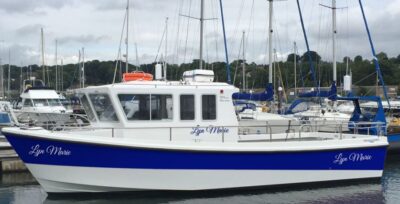
Address: 2 Glyn Cres, Black Pill, Sketty, Swansea
Post Code: SA3 5AT
Phone: 07970 685038
Website: https://www.lynmariecharters.co.uk/
Addional information; Lyn Marie is a Vigilante 33 built by Breaksea Boats. At 10m long with a beam of 3.8m Lyn Marie has as much deck area as some of today’s Catamarans and is remarkably stable both at anchor and on the drift.
Susan Jane Deep Sea Angling
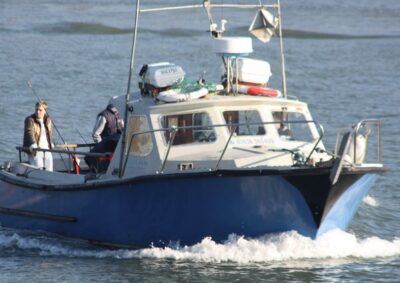
Address: Pill Moorings, Swansea Marina, Swansea
Post Code:SA1 1UN
Phone: 07774 906390
Website: http://www.susanjaneseafishingcharters.co.uk/
Additional information: The Susan Jane is a purpose built angling boat – a 33ft Lochin Fast Fisherman. Fully Licensed and Insured for 12 Passengers
Blue thunder
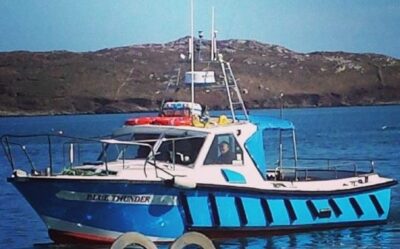
Address: Trawler Rd, Swansea
Post Code:SA1 1UN
Phone: 07703 797974
Website: https://www.facebook.com/Bluethundercharter
Additional information: Wreck & reef fishing,
Whale, Dolphin, Seal & Bird watching. Scenic cruises(beginners & children welcome) All rods and tackle supplied on board.
Sea Fishing Newport Cardiff Penarth Lavenock Bridgend Port Talbot
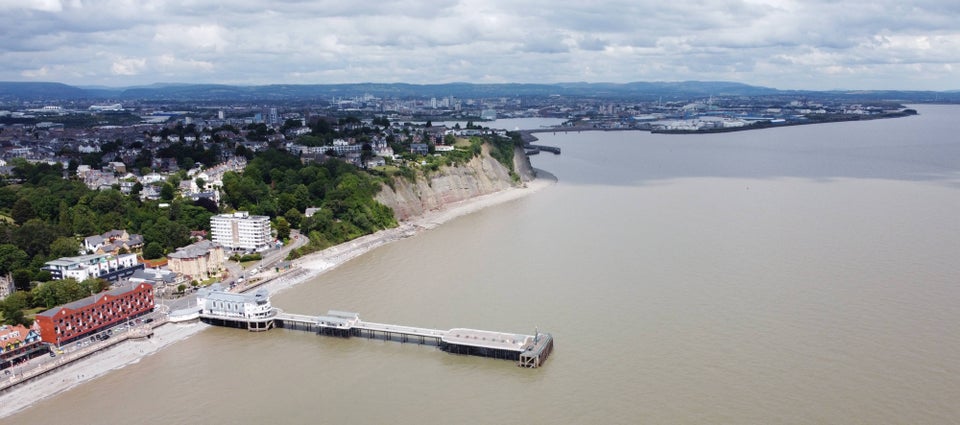
CARDIFF / PENARTH
Over the past decade, the Cardiff and Penarth area has established it’self as arguably the top rod and line cod fishery in the UK. But it doesn’t end there, for the summer fishing is just as good with a large variety of species, and for the adventurous there are also huge numbers of wrecks littering the seabed of the Bristol Channel within a couple of hours steaming.
The main port is Penarth, which sports a large marina facility, but charter boats also work out of the old docks in Cardiff too. The whole area though is undergoing massive transformation, with facilities improving almost daily.
WHERE TO FISH
The ground here is a mix of clean ground, rough patches, rock and coral reefs. Some of the more noted marks are The Ledge just off Sully Island, One fathom Bank off Barry, ground adjacent to Flat Holm Island, The Monkstone, and the sandbanks called Cardiff Grounds. Many of the boats make the longer journey westwards to the Aberthaw area and to the famous Nash Sands and Nash reef off Monknash, especially in the summer. It’s the Nash area that gives up the best variety of species. Reef ground is also visited on the English side of the Bristol Channel for conger, cod and tope in season. Long range trips to the wrecks are undertaken in the summer, with a few vessels pushing out the 70 odd miles to Lundy Island off Ilfracombe in Devon when the weather allows.
SPECIES
January, February and March still give good cod fishing here with the biggest fish, some touching 40lbs, showing during the mid January to end of February spell. Codling remain inshore right through until June, though their numbers obviously drop. By late April bass have moved onto the rougher patches along with thornback, spotted, and the first of the small eyed rays. All the rays, including blondes, are well established by mid May with early turbot also taken. By the end of the month, then attention turns to smoothound and some good fish well into double figures are caught along with the odd monster. Huss and dogfish, plus pack tope to 25lbs are also around. July and August sees some porbeagle shark move eastwards up the channel with the mackerel shoals. Shark average about 100lbs, but fish to 200lbs plus have been taken. The wrecks are well visited in June, July and August giving quality pollack to 15lbs, huss, conger, and rays. Monkfish move in on the sandbanks around the Nash, too. August sees the first codling back inshore, along with whiting, and whilst conger, rays etc, continue to be caught right through the autumn, most boats focus on the cod fishing from here on in.
TIDES The Bristol Channel has the second-biggest tides in the world, only the Bay of Fundy in Canada has larger, so this tells you that even the neaps run at a fair pace. The bonus is that the fishing does not differ too greatly on a day to day basis. Fish will be caught on all tides. Having said that, obviously any wreck trips have to be centred on the neap tides, and some shallower reefs are best fished only over the slack water periods. Very heavy and persistent rain water flushing down the estuary can push the cod out at times and effect the distance travelled by the shark during the summer. These fast moving channel waters never clear and always carry silt making the water permanently coloured.
TACKLE Due to the ferocity of the tides, this is mainly up tiding country. You’ll need big leads too, so choose an uptider rated to cast 4-10ozs using a multiplier loaded with between 18lb and 25lb line. Most anglers select the heavier line because big fish will have to be bullied back against the tidal current. Carry leads from 5ozs to 8ozs with both release and fixed grip wires. Sputnik leads with their oversize grip wires are very popular here. Keen local anglers tend to fish only a two hook pennel rig for cod and also for rays. Hook lengths need to be between 2-6ft. The uptider also does a good job on the wreck pollack, but what down tide fishing is practised can be done with a 30lb class rod and reel with leads around the pound. This down tide method is the best way to take the bigger cod by trotting a big bait well down tide of the boat.
BAITS For cod and general species you’ll not beat black lug or king rag baits, and make them big, at least 9ins long. Squid works well both as a tipping bait, or whole for the bigger cod and bass. Conger like a small pout or whiting. Edible and shore peeler crab is good for bass and smoothound over rough ground. Frozen sandeel is the best bait for the small eyed and spotted rays, with mackerel and herring strips okay for tope, conger etc.
ALTERNATIVE SHORE MARKS There are loads to choose from. Try Cardiff Foreshore for whiting, codling, eels, conger etc, in season. Redwick and Magor are good for codling and sole. Ogmore Deeps is a rock mark offering good ray fishing in the summer.
DevOcean Charters Penarth Portway
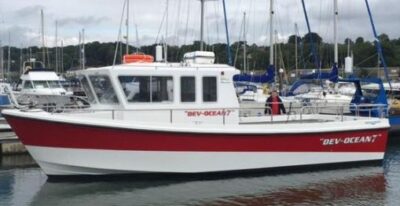
Address: Penarth Marina
Post Code: CF64 1SQ
Phone:07989 748701
Website: https://dev-oceancharters.com
Addiitional information: The Boat is powered by two Volvo Penta Diesel engines with a total of 520hp which can achieve speeds in excess of 40 knots. This means the trip can reach offshore fishing points in no time at all giving you more time to fish
tuskar 2 fishing charters
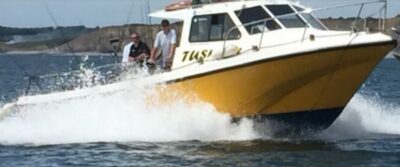
Address: Cardiff marina Cardiff Bay watkiss way
Post Code: CF11 0sy
Phone: 07710 234816
Website: https://www.facebook.com/tuskarcharters2
Additonal information: The Tuskar targets, cod, bass, blonde rays, spotted rays, thornback rays, congers, Tope, bullhuss, smoothhounds, sole, placie, dabs,
White Water Charters
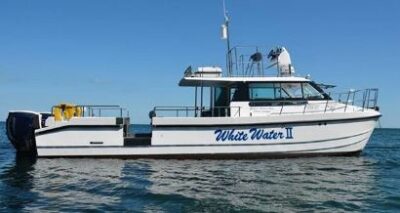
Address:Penarth Marina, Penarth
Post Code: CF64 1TZ,
Tel: 07970 936443
Website: http://www.whitewatercharters.co.uk/
Additional information: Water Charters operates out of Penarth in autumn/winter and Milford Haven in summer, during shark fishing season
SEA Bridgend Location; Porthcawl, St Brides, Llantwit Major, Aberthaw
These marks features rock ledges running into deep water on the left hand side, with flat ledges of rock running into a deep water gully and an offshore sandbar in front and to the right of the access point. The ledges produce smoothound and bass to short casts from June onwards. Conger, good-sized ones too, dogfish and occasional huss also show. Some anglers spin over the rocks in high summer for bass, small pollack and mackerel. Rays can be taken from the deep water gully at low water and for the first hours of the flood. Codling appear here during October and stay until March. Big cod can be hooked fishing into the deep gully, again at low water.
TIME AND TIDES:
The bigger tides produce the cod, smoothhound and rays, but rough conditions bring the bass inshore, even on neaps. Calm flood tides are best for spinning in the summer. Night tides are best for cod and rays, but daylight and dusk can be good for bass and smoothound in the right conditions.
BAITS AND RIGS:
Peeler crab is the only bait for the bass and smoothies. Black and blow lug takes the cod. Squid cocktails are good for the rays. Conger will hit all baits, but have a habit of hitting the smaller hooked pout on the way in. Rigs need to incorporate a weak link to the lead with most anglers opting for a clipped down single hook paternoster. Using Mustad Vikings and 25lb reel line means that snagged hooks will straighten to release tackle. Carry leads between 5 and 6ozs with grip wires.
WEATHER:
Fishes best in south-west to north-west winds. Easterlies can kill the fishing. Except in high summer calms, the sea remains coloured the rest of the time. During wet weather, in fact anytime, when walking near the cliffs keep a good distance out from them for rocks are continually falling.

Location; Port Talbot
The jack stones at port talbot is ok for some easy fishing, there are millions of whiting and pouting to be taken on fish baits etc. there are some nice strap conger taken at winter time as well as a possibility of codling or cod if things get really cold, but most are taken from the long arm pier at corus, but its worth a try. theres also a few dab taken. care should be taken on the large spring tides as the pier does become flooded and the jack stones can get very slippery, which makes landing your catch harder. All in all, its easy fishing for the lazy man. Dab and cod are taken on lug worm.
SEA Locations; Magor to Newport
